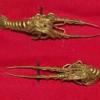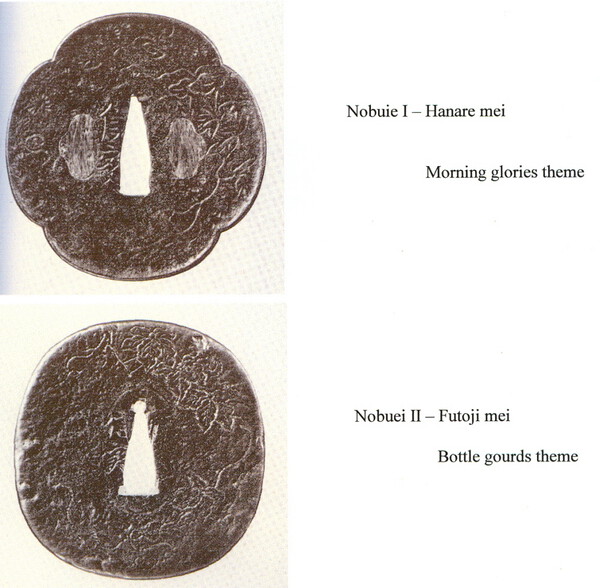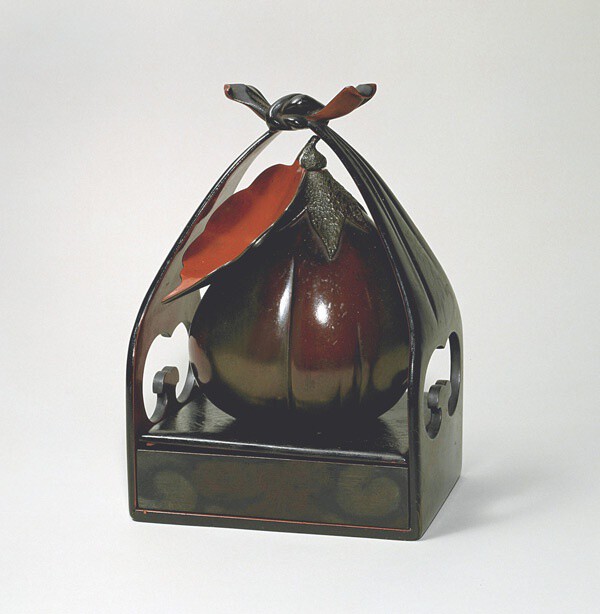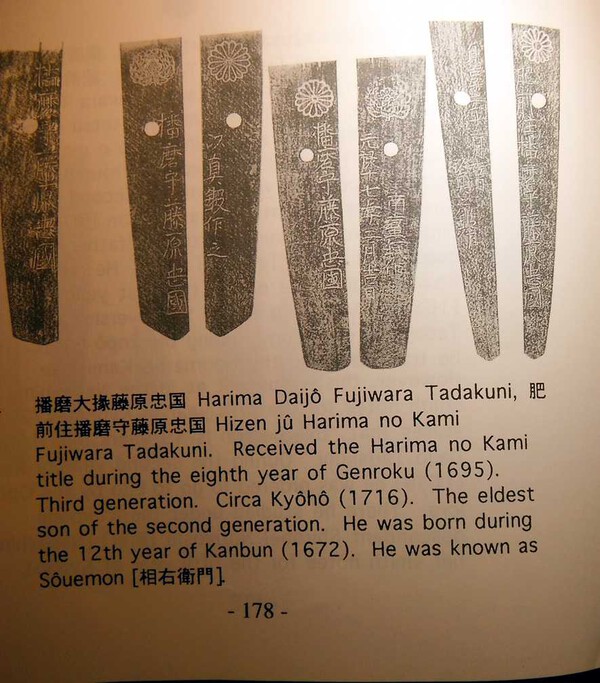-
Posts
435 -
Joined
-
Last visited
Content Type
Profiles
Forums
Events
Store
Downloads
Gallery
Everything posted by Lance
-
I found a link to this one that looks pretty close to yours (towards the bottom the article mentions Peter Bleed mentioning that it looks Ainu) http://therionarms.com/whatsit/ttoy4.html and an interesting link to another Ainu sword and mounts along with carrying belt/sash http://www.penn.museum/collections/object/129395 Regards, Lance
-
I'd agree and go with Shin-Shinto as well. (edited to add) If it were my sword I'd submit it to one of the upcoming US shinsa , especially worth it since you got it for a great price! Regards, Lance
-
Attached is a Showa era sword by Amahide, I think this might illustrate the type of hada some smiths produced during this time period by folding different steels together in a manner similar to your sword. http://www.nihontoantiques.com/fss188.htm There were some smiths who did this during Shin Shinto period, when experimenting with forging methods, maybe posting more pics of the whole blade and tang will help to provide you more information. Regards, Lance (edited for spelling)
-
Looks like it's similar to Katake Make style, often used on swords using Higo fittings, sometimes also referred to as "battle wrap but I don't know where that name came from (I would assume all tsuka are wrapped for battle? ) Below is a really nice example with leather ito http://www.nihonto.us/HIGO%20TSUKA.htm Regards, Lance
-
Sounds like muneyaki or extenended kaeri , but I think muneyaki usually runs further back along more of the mune http://www.ncjsc.org/gloss_boshi-1.html Other is probably tobiyaki, could be accidental or sometimes done on purpose any pictures you post might help identify wether it was intentional or not. Regards, Lance
-
I highlighted the part of the shinogii I thought you might be referring to on Christophe's Naginata, I'm guessing it's just an odd reflection and it doesn't dip down that way? Regards, Lance
-
I don't think this is necessarily true, Samurai were given their first real swords as children, to wear a katana/daisho was a birthright, not really something that required training (I can't count how many times I've read of elder Edo period Samurai despairing over the lack of attention paid to the military arts, in favor of poetry and calligraphy, as well as simple bureaucratic jobs.) There were also edicts prohibiting duels and cutting down the "lower classes" sometimes done by drunken Samurai when their form probably wasn't at it's best. More importantly I would imagine real sword fighting is a lot different than what would be learned in the dojo anyway, where the importance of perfecting skills and forms is to be completely familiar with your weapon, but in a real fight it is much more chaotic and messy and wouldn't be using the same exact movements during combat. (hate to say it as it's probably going to be taken as an overly crude example but the difference in training and a real fight is probably similar to seeing martial artists training and then seeing them fight in MMA) from my understanding the Code of Bushido, much ike the European Knight's Code of chivalry, was either something to aspire to but never truly followed to the letter by most or something romanicized by later generations. All that being said the opening does looks like it was probably a stress crack or welding flaw that formed during forging/hardening of the blade, might not even have been visible when originally made but became exposed due to polishing over the years. Plus since Shinano Nobuyoshi(s) worked during the relatively peaceful Edo period the likelihood of being involved in any pitched battle is rather small. Regards, Lance
-
I think it would be best to leave the paint as is. Having a new handle made or rewrapping the original isn't usually seen as a problem, but repainting the scabbard or mounts usually diminishes the value as most collectors I've seen would prefer swords that have honest wear instead of being "messed with". (Please keep in mind this is really only related to military/gunto mounts, not traditionally mounted swords, with them whole restoration process gets even more involved to do it properly, as well as what to restore and what to leave as is) Regards, Lance
-
Looks like Maruni chigai takanoha (crossed hawk feathers) below is a quick link I found with more info,: http://tenryuenglish.wordpress.com/2012/09/11/kamon/ A notable user of this mon was Asano Naganori, the main figure in the story of the 47 ronin http://en.wikipedia.org/wiki/Asano_Naganori Idon't think it would be possible to link the mon on any swords to a specific family due to the adoption of Kamon by non-samurai families during the Meiji period (I think, might be earlier) Regards, Lance
-
Is anyone (more) familliar (than me obviously) with the history of when magnfying glasses were first used in Japan? For example did they arrive with European traders or did thy already have them? I've always wondered if the introduction of optical-quality glass helped lead to the innovation of the fine detail work of the Goto and other schools but never really came across anything specific. Regards, Lance
-
Main tsuba on the page doesn't look like yours but a little further down the page there is one similar (top one in image below) Regards, Lance
-
Beautiful helmet, I also think the tehen is facing forward in the same manner as the Spanish helmets, but wanted to add it also looks to represent the stem of an eggplant, and is a very clever design utilizing the bowl of the helmet as the eggplant itself (even more so if the Japanese ever jokingly used a term similar to melon for a human head!) Attached a link and an image to illustrate: http://pinterest.com/pin/55732114111117646/ Regards, Lance
-
Looks like Kanehiro, Showa period? if so hiatsura would be rare for his time period, I don't think I've ever come across one. Love to see photos of the blade if possible. Regards, Lance
-

Read this signature, please? Thank you.
Lance replied to cmjohnson's topic in Translation Assistance
It wasn't so much a lack of skill (even though the person who made this probably wasn't a trained smith) There was a demand for Swords made from a rust resistant steel for the navy, and this is one of the results of that. If the blade's all scratched up and the shinogi is rounded it was most likely done later as they were usually finished quite well for what they were, and even though from an artistic standpoint there isn't much merit, most likely the person who made it thought they were doing their patriotic duty. Regards, Lance -

Fraudulent listings from China
Lance replied to JamesH's topic in Auctions and Online Sales or Sellers
Hello Jim, It's not a knock-off, the pics were stolen from the website below, as well as the person's other listings http://www.h4.dion.ne.jp/~t-ohmura/gunto_023.htm http://www.h4.dion.ne.jp/~t-ohmura/gunto_002.htm Regards, Lance -
Maybe something like this will help, a set of tools for removing a tight handle. (assuming it wasn't glued in with too much pine pitch) http://www.ksky.ne.jp./~sumie99/tools.html Regards, Lance
-
I think it was made by Hon-ami Koson in a way, consider 80 years ago was something of a revival for Japanese swords and other cultural aspects due to rising economic power combined with nationalism/millitarism, I think that the scroll was likely a Hon-ami Koson piece, then a (limited?) run was produced at the time, either in a way similar to the way woodblock prints or whatever modern technniques available at the time to make multiple copies. The shape looks reasonably close to Masamune tanto shape (disregard the well known Hocho Masamune "kitchen knife shape) My understanding is that most Masamune are identified as "named blades" possibly it's mentioned on the scroll and someone will be able to translate it for you, and see if it's an oshigata of a specific Masamune or just an idealized version. Regards, Lance
-
I disagree (only a little) and think the quality is better than mediocre, and would call them solid mid-level work. As Maruisz wrote they couldn't really be attributed to a school or group though, as they were most likely made by "town carvers") I cant remember which book(s) I read this, but supposedly many saya had this type of work added to existing or newly made saya, similar to what is seen on lacquerware boxes during/after the Meiji sword ban when they were sold for export or became decorative objects. I wouldn't do anything to the worn gold either, maybe have the tsuka rewrapped, this will also help prevent the menuki or kashirafrom getting separated in the future. Regards, Lance
-
I think once the buyer removed the stiching he voided your policy of returning it in the same condition as sent. The pictures you provided were clear enough to show the way the cover was stitched, and as others mentioned it does seem like the only reason he wants to return it is because he wasn't happy with what was under the handle. Regards, Lance
-
Thanks Jacques, I do have an Iyo No Jo Munetsugu, in learning more about Hizen school my impression was the Tadayoshi line/group always signed tachi mei for katana as well. I think that there might be (rare) exceptions to the rule out there, but in this case it doesn't matter as the sword posted is a wakizashi (also agree that a full length katana signed this way would raise doubts immediately) Regards, Lance
-
Looks like a real Japanese sword in excellent condition, newly polished /restored. Is the paper you mentioned an Appraisal by NBTHK or NTHK? Regards, Lance
-
Looks to be a good Daisho , I don't remember the reason for it, but the way the saya are scalloped on the back was intentional, maybe someone more familliar with koshirae can post why this was done... Also below are some oshigata and info for first and third generation Tadakuni, from the Hizento Handbook by Eguchi Soshin and translated by Gordon Robson, published by the JSSUS (didn't see any info inside for 2nd gen. there's mention of a 4th but no images) I had a question about the way Hizento were signed, prompted by Jacques' mentioning what side the poster's sword was signed on, One or two of the tangs illustrated signed katana mei look to actually be katana, instead of the way most mainline(?) Hizento are signed tachi mei on long swords, also included is a link from the British To-Ken Society that addresses this sort of, the last one is mentioned as being shortened and machi-okuri, but even before that it was only about 65 cm , shorter than standard lenth for Hizento so it's signed as if it's a long short sword. http://www.to-ken.com/full.php?article= ... &type=home So is this just something that's determined by blade length? (The Dai looks to be around 23-25 inches from the pics so maybe that's why it's signed that way if the mei is good. ) Regards, Lance













